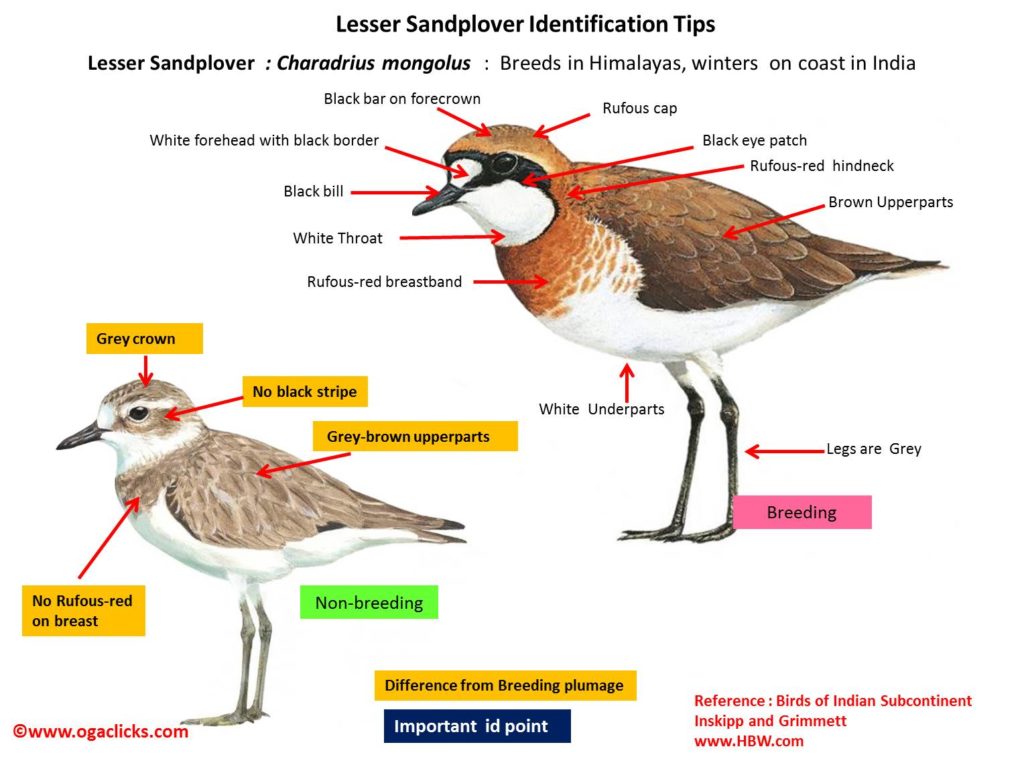
Lesser Sand Plover Charadrius mongolus
Etymology:
- Charadrius : Greek word kharadrios for unknown plain-coloured nocturnal bird that dwelt in ravines and river valleys
- Mongolus: From Mongolia
Vernacular Names: Guj: Nanirataltitodi, Nanidhongili, Ta: Mandiullan, Mal: Manalkozhi, Sinh: Oleyiya, Hindi: Chotabatan, Mar: Chotaretichilkha
Distribution in India: Breeds in Northern Himalayas. Winter visitor in coastal region of India
Description: Size of 18–21 cm; wt., of 39–110 g; wingspan 45–58 cm.In breeding plumage they have black eye patch, broad rufous-red breast band and hind neck collar; legs typically dark grey. Female like male but black on head is browner, no black line on forehead, rufous parts duller, and no dark upper border to breast band. Non-breeding adult lacks black and chestnut; grey-brown upperparts with pale fringes; large grey lateral breast patches.The juvenile resembles non-breeding adult with buff fringes on upperparts; face, supercilium and breast patches have some buff. Races generally distinguished (in summer plumage and especially males) using combinations of bill size, breast band, face mask and amount of rufous on head. Race pamirensis found in West India has a short narrow bill with poorly developed nail and gonys, sometimes shows more white on forehead than latter, as well as white spots in front of eye, with a pale rufous-cinnamon and narrow breastband, and virtually no black line bordering the upper breast. Race atrifrons in Himalayas and rest of India has better-defined and more extensive orange breast band and usually shows less white on forehead
Habitat:In breeding season found above or beyond tree line, mainly in mountains at altitudes up to 5500 m in Ladakh and Sikkim; barren valleys and basins, elevated tundra and mountain steppes, mainly near water, on moist but well-drained gravelly, rocky or sandy, sparsely vegetated surfaces. During non-breeding season found in coastal areas, frequently tidal mudflats, sandy beaches and estuaries
Food Habits: It eats mainly insects and their larvae, such as beetles and other invertebrates.Sometimes wade up to breast in water and insert entire bill into mud. It forges by running longer distances and more frequently, and pausing for shorter periods. It feeds solitary or in scattered flocks, often mixed with other waders, on mudflats, salt pans and salt marsh, rarely at water’s edge. Prefers softer mud over harder substrates. Sometimes forages at night.
Breeding Habits: They breed in April-June in NW Europe and NW Africa.Nest is a scrape or cattle footprint in bare sand or shingle, sometimes besides bushes or big stones, or among lichens .The nest has a lining of vegetation, small stones and debris accumulated during incubation. They lay a clutch of 2-3 eggs; replacement clutches can be laid if the eggs destroyed. They are single-brooded. The incubation period is 22–24 days, female often starts incubating first egg. The fledging period is 30–35 days; in most cases only males tend chicks, but sometimes both parents.